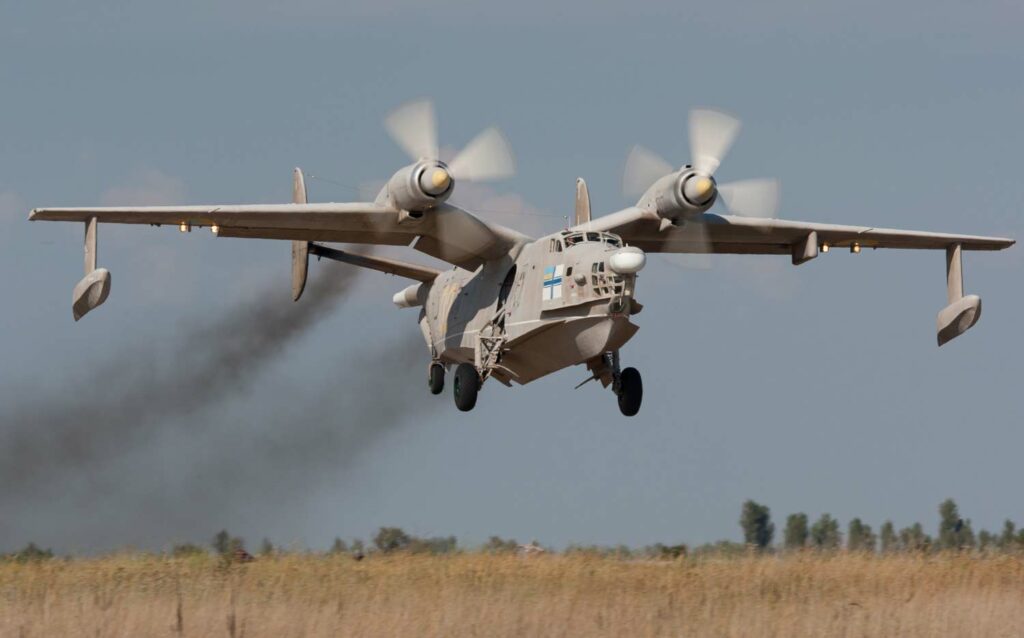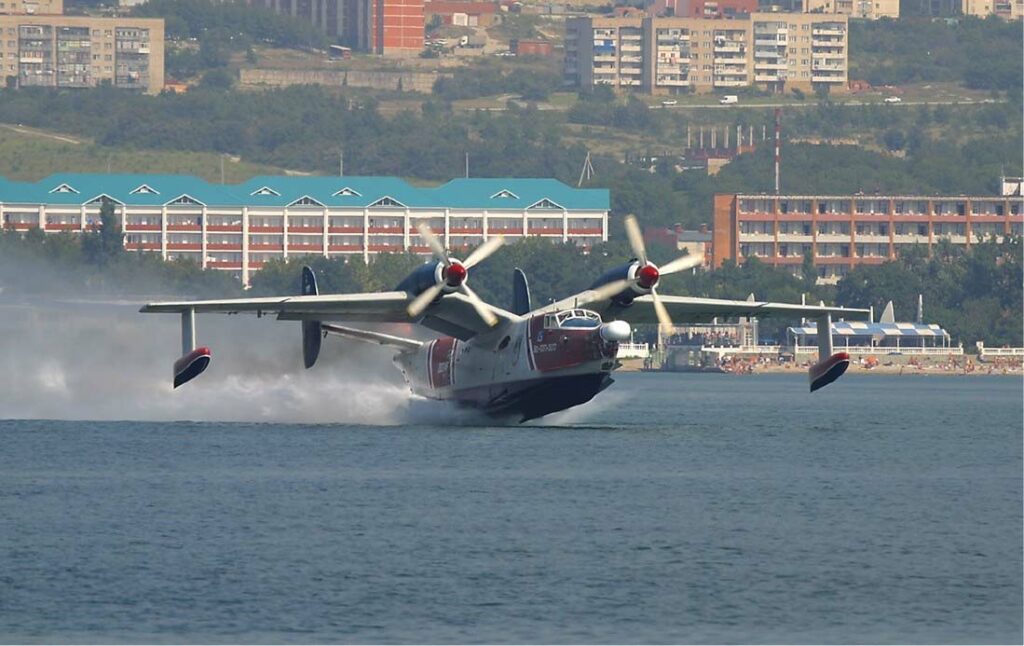The Beriev Be-12 Tchaika (Mail) is a Soviet amphibious aircraft designed for maritime patrol and anti-submarine warfare.
In brief
The Beriev Be-12 Tchaika (Mail) is a Soviet amphibious aircraft designed primarily for maritime patrol, anti-submarine warfare (ASW), and search and rescue (SAR) operations. Introduced in the 1960s, it features a high-wing, turboprop design with a distinctive boat-shaped hull enabling operations from water surfaces. Powered by two Ivchenko AI-20D engines, the Be-12 has a maximum speed of 435 km/h (270 mph) and a range of up to 3,500 km (2,175 miles). Its operational ceiling is 10,000 meters (32,800 feet). The aircraft is equipped with radar, magnetic anomaly detectors, and can carry torpedoes, depth charges, and mines for its ASW role. Over the years, the Be-12 has served in various capacities, including environmental monitoring and firefighting, showcasing its versatility beyond military applications.

History of the Development of the Beriev Be-12 Tchaika (Mail):
The development of the Beriev Be-12 Tchaika began in the late 1950s as the Soviet Union sought to modernize its naval aviation capabilities, particularly in anti-submarine warfare and maritime patrol. The aircraft was designed to replace the aging Beriev Be-6 and address the growing need for a versatile, amphibious aircraft capable of operating in the challenging environments of the Soviet Union’s vast maritime borders.
Launched by the Beriev Design Bureau, the Be-12’s development was led by Georgy Beriev, with the objective of creating an aircraft that could perform a wide range of maritime operations, from ASW to SAR, while being capable of taking off and landing on both land and water. The Be-12 first flew on October 18, 1960, showcasing its advanced design and capabilities.
The NATO reporting name “Mail” reflects the standard practice of assigning code names to Soviet aircraft for identification purposes. The name “Tchaika,” meaning “seagull” in Russian, signifies the aircraft’s association with the sea, highlighting its amphibious nature.
Design of the Beriev Be-12 Tchaika (Mail)
The Be-12 Tchaika features a unique design optimized for its amphibious roles. It incorporates a high-wing configuration to keep the engines and propellers clear of water spray during takeoff and landing. The aircraft’s dimensions include a wingspan of 29.8 meters (97 feet 9 inches) and a length of 30.1 meters (98 feet 9 inches), with a boat-shaped hull that facilitates water operations.
Powered by two Ivchenko AI-20D turboprop engines, each generating 4,000 horsepower, the Be-12 has a distinctive sound and performance profile. The engines are mounted on the high wing, providing the necessary lift and power for the aircraft’s diverse mission profile.
The design includes a retractable landing gear, allowing for land-based operations, and a magnetic anomaly detector (MAD) boom extending from the tail, essential for detecting submarines. The aircraft’s fuselage is equipped with bomb bays and external hardpoints for carrying a variety of ASW weaponry and equipment.
While the Be-12’s amphibious capabilities offer significant operational flexibility, they also impose limitations on speed and range compared to land-based maritime patrol aircraft. However, its ability to access remote and unprepared waterways compensates for these drawbacks, providing unique advantages in certain operational contexts.
Performance of the Beriev Be-12 Tchaika (Mail)
The Be-12 Tchaika’s performance characteristics reflect its role as an amphibious patrol and ASW aircraft. With a maximum speed of 435 km/h (270 mph) and a cruising speed of 300 km/h (186 mph), it is capable of covering vast maritime areas efficiently. The aircraft’s operational range of up to 3,500 km (2,175 miles) and ceiling of 10,000 meters (32,800 feet) enable long-duration patrols and high-altitude reconnaissance missions.
When compared to contemporaneous maritime patrol aircraft like the Lockheed P-3 Orion, the Be-12 offers unique amphibious capabilities at the expense of speed and payload capacity. However, its versatility in operating from both land and water bases provides strategic advantages in specific scenarios, such as conducting SAR missions in remote or inaccessible areas.
Variants of the Beriev Be-12 Tchaika (Mail)
The Be-12 saw several variants throughout its service life, each tailored to specific operational requirements:
- Be-12: The initial production variant, designed for ASW and maritime patrol missions.
- Be-12N: A modified version for navigation training, with specialized equipment for pilot instruction.
- Be-12PS: A search and rescue variant, equipped with additional life-saving and communication gear to enhance its SAR capabilities.
Each variant of the Be-12 underscores the aircraft’s adaptability to different roles, from training and reconnaissance to life-saving missions at sea.

Military Use and Combat of the Beriev Be-12 Tchaika (Mail)
The Be-12 Tchaika has primarily served in the Soviet and later Russian Navy, fulfilling roles in maritime patrol, anti-submarine warfare, and search and rescue operations. Its armament includes torpedoes, depth charges, and mines, making it a formidable asset in ASW missions. While the Be-12 has not been extensively used in combat, its presence has been a significant deterrent in maritime areas of strategic interest to the Soviet Union and Russia.
Throughout its service life, the Be-12 has participated in numerous exercises and operations, demonstrating its capabilities in real-world scenarios. Its ability to operate in harsh environmental conditions has been particularly valuable in the Arctic and Pacific regions, where its amphibious nature allows access to areas beyond the reach of traditional patrol aircraft.
While the Be-12 has not been widely exported, it remains in limited use for specialized roles such as environmental monitoring and emergency response. Its replacement in frontline military roles has been gradual, with newer technologies and platforms taking over its primary functions. However, the Be-12’s legacy as a versatile and capable amphibious aircraft persists.
The Beriev Be-12 Tchaika (Mail) embodies the ingenuity and adaptability of Soviet-era aviation design, serving as a testament to the importance of amphibious capabilities in maritime patrol and anti-submarine warfare. Despite its limitations in speed and range compared to purely land-based aircraft, the Be-12’s unique ability to operate from both land and water has made it an invaluable asset in a variety of military and civilian roles. As it gradually retires from active service, the Be-12’s legacy continues through its contributions to maritime security, search and rescue, and environmental protection missions.
Back to the Seaplanes section.